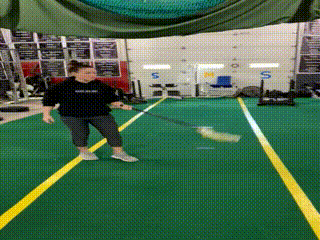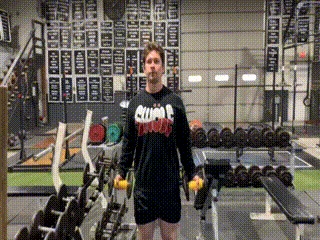How You Can Do A Forearm Workout For Athletes
How You Can Do A Forearm Workout For Athletes
The forearms don’t particularly come to mind when we think of muscles that make for better athletes. Our minds tend to race toward more powerful quads, a dominant posterior chain, or a torso with boulder shoulders and supreme dynamic trunk control. But the forearms? What in tarnation do they have anything to do with strength training for athletes?
To a degree, that is super valid. Your forearms don’t necessarily help you run faster or jump higher, typical movement patterns associated with athleticism. That’s a narrow view that lacks nuance though.
Our hands are very active in sporting activities, particularly open skilled and closed skilled sports that ask for the handling of an object or an opponent. If you have to hold onto a stick (lacrosse, field hockey, tennis/racquet sports), grab an opponent (wrestling, football, jiu-jitsu), handle an implement (shot put, discus, weightlifting), or maneuver an implement through space (basketball, baseball, football), forearm training can, will, and does benefit your athletic development, just like our strength training app, Peak Strength.
The Forearm Muscles
The forearm is the collection of musculature between the elbow and the wrist. It is a subsection of the arm. It is responsible for a lot of fine motor skills such as writing, playing instruments, and gripping.
Within the forearm, there are two long bones, the radius bone and the ulna bone. The ulna bone is the longer and larger of the two and is located medially (closer to the midline), and the radius bone runs parallel to it. These two bones are connected by the interosseous membrane.

The forearm does not lack muscles. There are a lot. By a lot, we’re talking twenty different muscles in the forearm that are responsible for extending and flexing the wrist, extending and flexing the finger digits, flexing the elbow (the brachioradialis), and pronating (think a pull up grip) and supinating (think a chin up grip) the hands.
Sports Application
Contemplating the forearm musculature from a sporting application mindset, we have to look through the lens of grip. The idea of holding on, not letting go, or nabbing something out of the air, or, to be more specific, procuring the football so not to fumble, grabbing an ankle to initiate an ankle pick in wrestling, or jumping up to secure a rebound. All done through the hands and, by extension, the forearms.
Our ability to grip, grab, and hold on is an important skill in almost all sporting endeavors (minus soccer–no hands allowed, unless you’re a goalie) to having success in competition. However, the degrees to which the grabbing, holding, and snatching out of the air is necessary, varies in needs from sport to sport.
Some sports ask that you hold onto an object or opponent. For instance, football, lacrosse, and wrestling all can fall into this category. Football asks for athletes to hold onto a ball, catch a ball, and grab onto opponents to complete tackles or initiate a block. Lacrosse has athletes constantly holding onto a stick that is twisted and turned with technical precision. Wrestling has athletes grabbing wrists, ankles, tight wastes, and locking hands for a mat return.

Other sports ask that besides holding onto an object or opponent, that you grab or snatch something out of the air, on the mat, or away from the competition. Concrete examples include catching an alley oop for a dunk in basketball, a wrist for control, or a frisbee out of the air.
In all of these instances of athleticism coming from the hands via the forearm musculature, you see training needs. Depending on the sport, athletes have a variety of needs. Athletes need their forearms to get strong, be explosive, and have the localized muscle endurance to keep firing throughout the duration of the competition and not fatigue.
Strength Training
Athletes benefit from strong forearms. Stronger forearms translate specifically to a stronger grip. From a stronger grip you are able to hold more weight to not only lift more in pulling movements, like the clean and snatch, but pressing movements like the bench press. All great movements in themselves for athletic development with high levels of dynamic correspondence.
With strength training, you need to think bigger, more powerful muscles. For bigger muscles, that means hypertrophy work. Hypertrophy work centers around accessory movements that can be done in a structural bodybuilding style with isolation exercises. A favorite movement here for forearm strength that athletes can perform is Zottman Curls (which we’ll discuss later in more detail).
Concerning more powerful muscles, that can come from bigger intensities, which means heavier weights, usually gained by performing compound movements. Pull ups and rope climbs are the go-to movements for such forearm development. Because face it, multiple muscles acting in conjunction are stronger than a single muscle acting on its lonesome.
Compound movements are so beneficial because they ask multiple muscles to recruit high threshold motor units as co-contractions to demonstrate strength. Athletes need this ability so it is important that their forearm muscles can work with their bicep and triceps muscles, as well as the musculature in the back and chest.

One last thing to be aware of with strength training for the forearms is that not all grips are created equal and rarely in sports will all grabbing be done in the same way. Meaning you have to vary the way implements are held.
Athletes need to be training their forearms using Garage Grips, neutral grips, pronated grips, supinated grips, monkey grips, towel grips, and with various sizes and shapes of objects. Simply hanging from a cylinder vs a bar vs a towel vs tennis balls vs vertical pipes vs being supinated or pronated or neutral can make a whole world of difference.
Impulse Training
Impulse is force X time. Impulse is the one thing all athletes need to concern themselves with for developing that explosivity and speed that is so crucial to success in competition. At Garage Strength, we believe Impulse is so important we dedicate a whole day to it and we have a whole day dedicated to it in our strength training app, Peak Strength, as well.
The same applies for the forearm musculature. Impulse as an athletic application must be applied to the forearms by having actions and exercises performed at high velocities.
It is one thing to prep and grab onto something, like holding onto a tennis racquet, in and of itself important, but it is another thing to quickly flex the wrist to strike the ball so it goes in the exact direction intended.
The same goes for procuring a lower limb in wrestling. Where strength training of the forearms is responsible for the ability to have a firm grip, impulse training of the forearms is responsible for making the action rapid–think the quickness in which the hands reach out and close around an ankle or wrist. You can even think about high level athletes quickly extending their hands and nabbing a ball out of the air.
That’s forearm impulse.
Muscle Endurance
Another way athletes need to think of forearm training is around muscular endurance. Localized muscle fatigue is a thing. Sometimes your ability to hold on goes away–you can’t do that next pull up because your grip is gone or you can’t deadlift any more reps because the bar is slipping out of your fingers.
Increasing muscle endurance in the forearms is important for athletes. As competition persists and the game battles late into the match or 4th quarter, you don’t want to be letting a takedown get away because you’re unable to hold on for the time frame required due to fatigue or you’re unable to make a block because you couldn’t hold on long enough for the running back to scoot by.
Training muscle endurance is a grind. It takes a tenacity that is both mentally taxing and physically exhausting. Muscle endurance means sets with lots of reps, long times under constant tension, and feeling the lactate build up to create that burning sensation.
In Garage Strength Program Design, training localized muscle endurance is often attacked through rep schemes and, for muscles like the forearms, handled during accessory movement selections.
Exercises (6)
Athletes use their hands a lot. The forearm musculature is responsible for a lot of that action–grabbing, holding on, and snatching all come into play.
Let’s look at a few exercises, and exercise groupings, that do a great job of training the forearms either with a strength focus, impulse focus, or muscular endurance focus.
Towel Pull Ups (Strength Focus)
The pull up is a phenomenal compound movement that creates great strength in the back, biceps, and forearms. Being that the pull up is one of the absolute best upper body pulling exercises in existence, it also asks a lot from the forearms.

By pronating the grip on an EZ bar, you will engage the forearms in a unique method. The atypical means of gripping the bar puts a heightened aspect on the neurological adaptation upon the forearms and the curling motion.
The addition of the Garage Grips creates a wider surface area for even more high threshold motor unit recruitment.

Plate flips are a rapid movement that is not only explosive, but asks for the hand to snatch and grip the plate with an atypical grip. Usually our hand wraps around something similar to a baseball or a pull up bar. Not the case with a plate flip.

Rope climbs are great at building forearm strength. They are also great at building the forearms impulse expression capabilities.
Think about the exercise of the rope climb. You have to rapidly grips, release, reach, and grip. The repeated movements are fast, explosive, and require a ton of coordination.
Where the Olympic lift of the jerk and its variations are the go to push movements for technical coordination exercises, the rope climb is the upper body’s pulling equivalent. You read that correctly: rope climbs can function as technical coordination exercises for the upper body.
How and why? Rope climbs require that you move relatively heavy weight fast. You also need to be explosive when grabbing the rope. Rope climbs also have high technical demands and ask for many muscles in the upper body to coordinate together to successfully complete the exercise.

The forearm roller is an old school exercise that is great for developing grip strength and extending that very necessary muscular endurance required late in a wrestling match.
The forearm roller can be constructed with a rounder cylinder of various sizes. Don’t make it so large that it can’t be gripped, but it also needs to be large enough to simulate a wrist, an ankle, a forearm, or a calf. In the center is a rope. From the rope dangles a weight.
The forearm roller apparatus allows you to roll the weight up and then unravel the weight to unroll back down. You will want to do this for a set amount of time. For instance, a duration of 5 minutes of continuous rolling up and rolling down is great for building localized muscle endurance in the forearms.

Any wrestler, grappler, or BJJ athlete who has trained at Garage Strength knows the infamous Zottman curl.
Bicep curls are a hallmark exercise of any athlete participating in a sport that has a lot of pulling demands, namely wrestling. The Zottman curl, though not necessarily the best for peak loading and the highest intensities, is more notorious for the forearm burn it accentuates during the eccentric portion of the movement, which is great for muscular endurance.
Having a dumbbell in each hand, you perform the concentric portion of the lift like a typical dumbbell bicep curl, having your hand in a supinated grip. However, during the eccentric of the Zottman curl, you pivot your hand, so your grip is pronated as the dumbbells are lowered. The pronating and supinating of the wrist is great for the forearms.
It is important to control the eccentric to increase that time under tension and really feel the forearms work here. The burn is for real.
Because the exercise is being done with muscular endurance in mind, the number of reps needs to be in the 17+ range. Throwing in the use of Garage Grips is a positive protocol to make for a stronger grip.

Sample Forearm Workout (Upper Body Power Day)

Sample Forearm Workout (Hypertrophy Day)


The Bottom Line
Training the forearms does not seem likely to be an obvious set of muscles to train to contribute to overall athleticism. However, upon a deeper dive, athletes realize that the hands are used excessively in sporting endeavors. Because the forearm musculature is so heavily responsible for the movement in the hands, it is important that athletes train the forearm musculature.
Take either of the provided sample workouts and run through one of them next time you are in the gym. Or better yet, try both sample workouts over the course of a week when targeting your forearms.
If you are looking for a more robust, periodized program that is sport specific to your fitness needs, the premier strength development app for athletes, Peak Strength, will create a program from over 700 exercises to sculpt that athletic physique you’re looking for. Try a week of workouts for free at peakstrength.apptoday!


EARL KUNKEL
3x World Champion Co-Author of the Year
King of the PA Press
Blog Topics

Yo, It's Dane
Welcome to the Garage Strength Blog, where it is my goal to provide you with the experience and knowledge I've gained in the strength and conditioning world over many years of learning from both successes and failures. I train elite-level athletes in a multitude of sports from the high school to professional levels, already producing 5 Olympics and 30+ National Champions. If you want to be the next champion I train, check out my strength programs below!
Start Training With Me

Join for free educational videos EVERY WEEK on strength coaching and athletic performance

